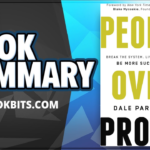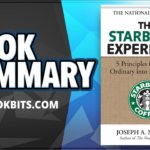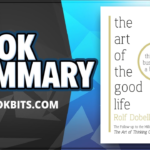★DOWNLOAD THIS FREE PDF SUMMARY HERE https://go.bestbookbits.com/freepdf
? MY FREE BOOK TO LIVING YOUR DREAM LIFE” https://go.bestbookbits.com/first-seven-steps
? SPONSOR BESTBOOKBITS BY USING PATREON https://www.patreon.com/bestbookbits
? SUPPORT BESTBOOKBITS BY CLICKING THE LINKS BELOW
- 150 PDF Summaries: https://go.bestbookbits.com/150
- Coaching Program: https://go.bestbookbits.com/coaching
- Subscribe to My Channel: https://www.youtube.com/bestbookbits?sub_confirmation=1
- Website: https://bestbookbits.com
- Instagram: https://www.instagram.com/bestbookbits
- Spotify: https://open.spotify.com/show/0q8OW3dNrLISzyRSEovTBy
- Facebook: https://www.facebook.com/michaelbestbookbits
- Book Club: https://bestbookbits.com/bookclub/
- Mailing List: https://mailchi.mp/d1dfc1907cdb/bestbookbits
Summary
Stick means understood, remembered and with the capacity of making an impact.
The Heath brothers introduce the “curse of knowledge” as the great enemy for your ideas to stick. The person sharing the idea knows all the nuances the receiver has no idea about.
So he often ends up glossing over core information, or indulging in too many details.
The authors highlight the principles are not a mathematical formula which will guarantee your ideas will stick, but they are proven methods that will increase the likelihood:
Chapter 1: Simple
Simple ideas stick, complicated ones don’t. To make your ideas simple:
- Present the core of your idea
- Share it in a short form using the 6 principles (SUCCESS)
The authors suggest you use the inverted pyramid of journalism, such as starting from the most important aspect, then add important details, and then all the other background information.
I particularly liked the idea of CI, or Commander Intent, very useful when you need people to act on your behalf in a big organization.
It’s a very short and simple sentence that sums up the overarching goal of the organization and function as a filter for localized decision making.
Southwest Airline’s CI is “we are THE low fare airline”. So nobody would think to gift trinkets on board because it’s not in line with the CI. In Bill Clinton’s campaign it was “it’s the economy stupid”, so that everyone knew what to focus on.
Analogies and metaphors can also help simplify complex issues. For example Disney calls the staff in their parks “cast members” as it project its parks as theaters. Disney doesn’t need to explain why it’s important to behave in a certain way to its employees: being a “cast member” reminds everyone they’re always on stage.
Chapter 2: Unexpected
Attention is key in making your message stick say the Heath brothers. We need to both get attention and keeping it.
As Thinking Fast and Slow explains, our rational part of the brain only starts paying attention once something is out of the ordinary. So the key to get someone’s attention is to break their patterns, or to surprise.
The example of grabbing attention with the unexpected is the buckle up campaign:
To keep attention the authors introduce Robert Cialdini‘s breakthrough when Cialdini found out how mysteries kept people’s attention. Mysteries are so powerful because they create a need for closure. Your goal is raise questions, open gap of knowledge with mysteries and piquing curiosity.
The Heath brothers suggest you:
- Identify your core message
- Present it in a counter-intuitive way people don’t expect
- Introduce a mystery and explain it with your message
Note: in a quest for the unexpected some advertisers focus too much on grabbing attention in ways that do not relate to the content. You must always grab attention in a way that relates to your content.
Chapter 3: Concrete
The easier we can relate to something, the more we understand it and remember it. Concrete is something the senses can capture and something that we have already experienced.
So similarly to what Jay Samit and Charles Duhigg suggest, the Heath brothers say you must link a new idea to something familiar. For example to introduce Speed to Hollywood producers you pitch it as “Die-Hard on a bus” and Alien becomes “Jaws on a spaceship”.
Joseph Sugarman in Triggers said a great way to sell the first and unknown smoke detectors was to pitch them as “electronic noses”.
The authors also compare the (in)effectiveness of complicated CEO’s parlance such as “maximize shareholder values”. Too often missions statements sound like meaningless hot air nobody cares about.
Compare it instead to what fueled US’ efforts for a decade. When JFK made the government’s mission to “land a man on the moon and returning him safely to the earth“. That’s concrete and clear.
The curse of knowledge comes into full force here. Experts tend to see things at a higher, more abstract level than novices and the danger is that they will explain it in more abstract terms as well.
Last but not least the Heath brothers says that our memory functions in the form of “hooks”. The more familiar and concrete hooks our message has, the easier it will be to remember.
Chapter 4: Credible
To make your idea credible the Heath brothers present a few different triggers:
- Authority
- Anti-authority: people who experienced firsthand the nefarious consequences (ie.: smokers)
- Details: the more details we hear, the more real it seems; details are often a proxy for expertise
- Statistics: not the raw numbers though, highlight relationships, contextualize them in a way that’s human
- Sinatra test: if you’ve already done in difficult environment, you’re credible to do it in easier ones
- Testable experience: if they experience it firsthand they believe it more. This is Reagan asking “are you better off then you were 5 years ago”? Or Wendy providing verifiable facts about their bigger burgers
A great example to contextualize a statistic. Imagine you have to explain how accurate is a missile. You could say it can be shoot from the sun and hit within a Km of the target. But to humanize it you would say it goes from New York to LA and hit within 5cm. The distance has been humanized because people have no idea of the sun-earth distance.
A great way to make your message you’re credible is to have the audience test it themselves. Without knowing. For example a non-profit picked up potential donors to meet them. And then told them how successful they were in turning homeless people into honest workers. One of them was their own driver (surprise).
The authors say that Wendy successfully prodded consumer to experience firsthand -or confirmed firsthand experience for those who tried already- that their burgers had more beef meat
Chapter 5: Emotional
Emotion is about making people care. People who care act. The authors quote Mother Teresa when, paraphrasing, she said:
People will do for the one what they will not do for the many.
A research shows how people who heard a story about a single child donated more than when they heard about the big numbers related to the same problem. The reason is because the numbers appeal to our analytical brain while the story appeal to our emotional centers -the same decrease in donation happened if people were asked to perform calculus-.
Interestingly, combining the story with the data did NOT produce better results contrary to one might think (ie.: “if I used both logic and emotions I’m fully covered”). So it’s best to know both and use them depending on your audience or situation, but not to blend them.
The Heath brothers say to call to action you can appeal to:
- Self Interest(WIIFM): use “you”, talk benefits to them & not feature. Let them imagine
- Associations: link something they care about to your message
- Identity: Sometimes we don’t pick what’s best for us but what’s best for the group we belong to. Or based on our “ideal self image”
The authors debunked the Maslow hierarchy saying people pursue all the benefits simultaneously and not one after the other. Emotional is actually about getting out Maslow’s basement. Appealing to pure self interest with only money bonus will crowd out higher engagement as people feel “bought out” and ultimately less motivated.
A couple of emotional ads examples are the anti-cigarette campaign that depicted teenagers delivering body bags to a big corporation. Teenagers smoke to rebel, but the ad showed “The Man” being the evil corporation. So now non smoking is rebellious.
Texas government found it hard to make people stop littering. So they used identity. They had very Texans icons embody Texans virtue telling not to litter.
Now the people heeded: being a Texan also meant respecting Texas and not littering:
Chapter 6: Stories
Sticky ideas often use stories with simple plot that people can relate to. And that inspire us. The authors say that a story lit in our brains the reenactment of that story which “burns it” in our brain.
The Heath brothers introduce three different types of story:
- Challenge Plot: the underdog story, overcoming adversity, inspiring grit
- Connection Plot: relationships, people overcoming discrimination and social gaps
- Creativity Plot: people moving around obstacles with ingenuity and smarts
Stories also help lower the audience’s guard. While pitching them your idea often get people to look for cracks in the idea, a story will get them engaged and think for themselves.
Epilogue:
The authors say this is not a checklist that will guarantee your idea will stick, but it will help.
To make an idea stick it must make the audience:
- Pay attention (unexpected)
- Understand and remember (concrete)
- Agree and believe (credible)
- Care (emotional)
- Be able to act on it (story)
★DOWNLOAD THIS FREE PDF SUMMARY HERE https://go.bestbookbits.com/freepdf
? MY FREE BOOK TO LIVING YOUR DREAM LIFE” https://go.bestbookbits.com/first-seven-steps
? SPONSOR BESTBOOKBITS BY USING PATREON https://www.patreon.com/bestbookbits
? SUPPORT BESTBOOKBITS BY CLICKING THE LINKS BELOW
- 150 PDF Summaries: https://go.bestbookbits.com/150
- Coaching Program: https://go.bestbookbits.com/coaching
- Subscribe to My Channel: https://www.youtube.com/bestbookbits?sub_confirmation=1
- Website: https://bestbookbits.com
- Instagram: https://www.instagram.com/bestbookbits
- Spotify: https://open.spotify.com/show/0q8OW3dNrLISzyRSEovTBy
- Facebook: https://www.facebook.com/michaelbestbookbits
- Book Club: https://bestbookbits.com/bookclub/
- Mailing List: https://mailchi.mp/d1dfc1907cdb/bestbookbits













